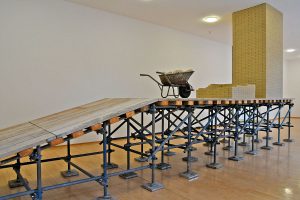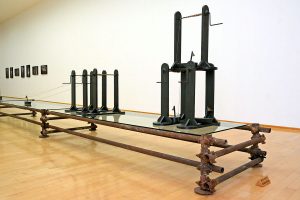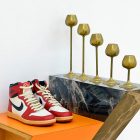
Display #37 – Untitled (wheelbarrow, bricks), 1995. Foto: Rüdiger Dehnen
(Translation: Alexander Schlutz – Foto: Rüdiger Dehnen)
Things are not what they are. They are what we know, what we think about them. They are what we allow them to be. To see is to categorize.
The new does not exist, for we turn it into the old. The more precise the drawer, the more gigantic the disappearance.
Man
A thing is only free while it has not yet become a graspable thought in the brain of the user/onlooker/listener. Whoever wants to give things their space needs to look at them constantly anew – needs to find new angles of observation. New positions. Art is thinking about things, and just as everybody thinks in different ways, everybody arrives in the end at different conclusions: In the process of making. In the process of using – which is the process of looking. Art is the constant renewal of the ordinary and the everyday. What remains ordinary becomes wallpaper without design. Quite often rituals hold our life together, but art in the best-case scenario is no ritual – it is a flight over known territory that is new every day. To explain art is perhaps an act of destruction…
Nevertheless a report on an exhibition is called for. It is one of those exhibitions that confirm things by way of dismantling them, or at least by bringing about new relations of thought. At issue is the litany of the seemingly everyday, onto which wings have been pasted. The name of the person exhibiting in the Museum Kurhaus Kleve (mkk) is … one almost wants to leave out the name, for somebody like Haim Steinbach has of course long become his own drawer, and sometimes nothing is more devastating then to be in competition with oneself. Nevermind – the name has been mentioned and is nevertheless beside the point, for the point of the thing and how to live it is the issue. What’s at stake is to dive into the everyday, which is resurrected in changed form a the other end of an unpronounceable thought – new every day. (Every single day.)
Letters can make a difference. Every day – that’s where the inescapably normal is at home. Every single day – that’s almost a prayer made of words.
Heimbach is one of those artists who allow things to be more than is usually granted to them. Things – they can be colors, objects, letters, agreements of perception. What’s being thought behind the word “steering,” depends on whether somebody is sitting in a car or thinks about a committee. That a color is called what it’s called does not describe its property, nor its quality. The fact that a house always had a door in a specific place is meaningless if somebody comes and walls up the opening. If a museum invites somebody like Steinbach to create an exhibition, it is to be expected that more will happen than the arrival of boxes that one can unpack in order to subsequently distribute their contents in the house. Somebody like Steinbach distributes the house itself anew and produces thought barriers that are none. Steinbach’s variation of things is an opening … if one is open to it. Somebody who isn’t open might grow lonely in an exhibition like Every single day and experience his or her freedom of contemplation as paralysis. (Which would be too bad.) One can see works from the past 30 years at mkk. Should one call something like that a retrospective? In the easiest case, this is an academic question, for Steinbach’s works are – as all great art always is – timeless. But what does timeless mean after all? The word is what we allow it to be. The slighter the warrant, the more narrow-minded the outcome. Every single day is an exhibition that leaves traces – an exhibition that one can take home, one that sinks its teeth into one’s conception, one that speaks of return, one that almost acts like a drug if one forbids oneself to think for a moment and settles into the direction of one’s feelings. The what’s-the-purpose-of-all-this question somehow is not an option. Steinbach needs coworkers, accomplices. Yes – it’s often enough described here: Things do not even exist if nobody is there to perceive them – to make a space for them in the well-proportioned attic of free thought. But this is also true: things survive us. Every single day tells of both these truths. Steinbach tells of things by getting things to tell stories – by giving them space and interrogating them. How do you interrogate a word, a color, a space? Maybe by going to the mkk and facing the answer.
Really …?
Übersetzung: Alexander Schlutz
Really, does a sneaker belong in the museum? Counterquestion: Does a towel rack belong in the museum? Answer: If it has matured enough – meaning if it is old enough – then yes. Contemporary art is tricky business. It won’t keep still. It’s recalcitrant. One searches for explanations. It’s just as it is with music. By common agreement, Mozart is beautiful. Ligetti raises questions.
Susanne Figner is curator at the Museum Kurhaus Kleve. She curated the Steinbach exhibit. She could talk for hours: about the works, the artist, what’s behind it all, the scaffolding of thought, the exceptional of the everyday, the visible and the invisible. Let’s start with the invisible. And already we’ve reached the first necessary qualification, for: Steinbach makes the invisible visible. He shows work. What’s behind it all: a wheelbarrow on a ramp, at the end of which a tower of bricks rises to the ceiling. Steinbach is not content with showing the tower – he highlights the process that leads to, leads into existence. This way, says Figner, a social context comes into being. Which is something one likes to submit to critical questioning – in contemporary art.
Painters of strata
One accepts Van Goghs drawings of the mining milieu as art. Steinbach’s everyday objects are saddled with questions. Is that an effect of figuration? Is it an effect of the traditional form of the beautiful on the one hand and being ill at ease with respect to the contemporary on the other? Does the everyday only become art if it makes it into the museum? What is the difference between a towel rack from the middle ages and a plastic madonna from the present? The painters of the past also did not simply paint to paint. The were secretaries of the temporal – painters of history. Painters of stories. Painters of strata. All too often, art was something for the well-off.
Back to Steinbach. Are words art? “No elephants.” – that’s what one reads on one wall – black on white, word on wall. Maybe one thinks of the pink elephant on a bike, of which one actually shouldn’t think. But perhaps one also knows that the Republicans in the States use the elephant as their party symbol. Already the writing has changed, but it’s not the writing on the wall that has done so – it’s the meaning in one’s head. Everybody brings themselves when they come to art. That’s how connections develop.
Pre-View
“Haim Steinbach is a political person,” says the curator. But Steinabch is not somebody who puts his viewpoint in the foreground – he is somebody who is concerned with viewing. And yet, art is of course about both viewing and viewpoints. Maybe Steinbach is somebody who thematizes ambiguity without talking about it. Art arises in the dialog between what’s delivered and the expectations. Often enough, the present moment founders on the expectations of the audience. No – this is no accusation. Steinbach’s art is a plea for taking a look, for art only develops – one has to write it again and again – in dialog. The Mona Lisa does not exist either, if one closes one’s eyes, but she has long since become a pre-view in millions of brains. What Steinbach puts into the museum are previews of another kind. Somebody like him is able to intone the song of the everyday, but that isn’t representable in either major or minor. No elephants.
And then there’s the mattress: Worn out it stands in a new wardrobe. Is a cynic at work here, somebody who mines the misery of the poor for the purposes of his career? Of course one can read it that way, but one can also read it as somebody saying something about the steep incline of a society. “Well, let him write a book,” some might say, but: Steinbach is no writer – he’s an awaker. By changing the surroundings somebody like him charges objects with a new energy. Nobody needs to endure a Mona Lisa – a mattress as an offer for a dialog in the museum is a different issue. Steinbach is not simply content with the beautiful, but he is thank God (!!) also not a finger-pointing guru, no lecturer with a laser pointer – he is a kind of trojan horse. He moves to the Kurhaus and sets up a shelf – full of the kitsch of the 50ies and 60ies, armed with Brockhaus knowledge. What emerges is a general store that – one only notices it on second thought – becomes a barrier, that now blocks the way to the towel rack, the towel rack that everybody loves to see, the towel rack that has sanctified itself through time. “Think,” whispers the shelf, “think what the towel rack once was: an article of daily use. And what am I?” Nobody says all this. Nobody has to think it, but one thing is certain: Steinbach poses questions. He doesn’t pose answers. He creates new spaces in old subject matters – expands through narrowing and narrows through expansion.
Things are not what they are. They are what we know, what we think about them. They are what we allow them to be. To see is to categorize.
The new does not exist, for we turn it into the old. The more precise the drawer, the more gigantic the disappearance. Steinbach also discusses the institution of the museum. Art History Writing. Writing art history. The art of writing history. Heimbach transforms the museum into a social reception room. His art – an invitation. Whoever dares accepts it.

Foto: Rüdiger Dehnen

